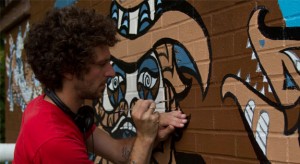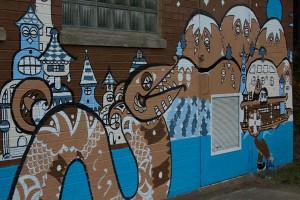One brushstroke at a time, artist Sean Chilson is transforming the abandoned New York State Electric and Gas pumping station in Ithaca into a vivid work of art.

Covering up the old “666” and “THC” tags, the vibrant blue and brown painting of life on Cayuga Lake has replaced the old graffiti that once covered the structure. Sitting across from the intersection of Routes 79 and 13A, this new mural is part of a growing movement to combat the recent increase of graffiti in Ithaca.
The Mural Street Art Project, a subset of the Ithaca Public Art Commission, was first organized two years ago to combat city graffiti.
Sally Grubb, a member of the mural street art project subcommittee, said the group is working on bringing art to public spaces in Ithaca, and murals are less expensive than installations.
“We were looking for a low-cost way of increasing public art,” she said. “At the same time, the city was working to reduce the amount of graffiti in the city.”
Brody Burroughs, an art lecturer at Ithaca College, painted the first mural two years ago on the parking garage at Green Street, right after its construction, to prevent graffiti. Brooklyn-based Jonathan Matas made the second mural, featuring Harriet Tubman and Frederick Douglass, under the Aurora Bridge last summer.
Several other murals have been painted in the area since then. Grubb said the program has plans to use many other spots around the city as surfaces, and is trying to fundraise and attract artists.
“The goal is to replace graffiti with street art and murals — to increase the art vibrancy in the city of Ithaca,” she said.
Funding comes from a combination of grants, fundraising and individual donations. Artists can apply on a rolling basis, with ideas reviewed once a month. The PAC welcomes all themes, but asks that they relate to the communities in which the murals are painted.
“They can be indoors, outdoors, can be temporal or long-lasting,” Grubb said. “There is far more potential for us to be able to find artists willing to work for small amounts of money and find funding from those who will give grants to support our projects.”
Chilson first applied in the beginning of July and found out he was chosen about a week later. He began his mural the second week of August but is not finished due to rain delays. For him, art comes as a second nature.
“I have made art since I’ve been old enough to figure out what a pencil is, or a marker,” he said. “I drew on walls all over my parents’ house and really made them mad.”
Nowadays, he designs T-shirts, tattoos, skateboard decks, car detailing and, most recently, the pumping station’s mural.
After researching the area extensively, Chilson decided to paint its historical and mythical history. In front of smiling snow-topped mountains, oddly shaped houses, the historic boat “Busy Bee,” and even T.D. Wilcox — the longest-working steamboat captain — the art piece shows “Old Greeny,” the giant legendary lake monster, as he rises out of Cayuga Lake.

While graffiti has a history of being considered art by some, most of the graffiti in town is “more sprawl or tagging,” rather than street art, Chilson said.
Graffiti has also spread up to South Hill. In addition to names and doodles, the “Steezus Christ” image showed up across the college last spring. It’s a simple sketch of Jesus with the words “Steezus Christ” written below in a typical graffiti font.
Paul Wilson, assistant professor of art history at the college, studies contemporary art and visual culture. He said while he can see the value in graffiti, having local artists paint more permanent murals might be more visually appealing.
“[Graffiti] is a form of art,” he said. “Any art is on a scale … but just because graffiti is art doesn’t mean it’s good art.”
Jeremy Long, assistant professor of art, who teaches most of the college’s painting classes and introductory drawing class, said he feels graffiti often has the capability to be a great art form but has not been so far in Ithaca.
“When it was invented in the mid-to-late ’70s in New York City, it was very potent and had a real reason for why it was done,” he said. “When it’s applied with those thoughts, it seems to be provocative. But I haven’t seen anything as interesting in the last 30 years.”
But there are a few instances of the lighter side of graffiti that have gotten better reactions from the town. The “Ithaca Graffiti Monster” has shown up in nearly 50 spots, and sighting it has become a hobby for townies. This Yeti-like monster from Ithaca seems to be the product of several different artists, given the differences in style, technique and location. Call it Ithaca’s own Banksy tag.
Sophomore Leah Nielsen, an art minor who has spiced up previous residences with late-night graffiti artwork, suggested establishing a wall somewhere as a way to prevent sporadic graffiti.
“Graffiti is cheap, it’s automatically on display for the public, and, what’s more fun, it’s illegal,” she said. “This means that it attracts true artists, as well as people looking to deface a wall with their name in stupid lettering.”
Chilson said while the new murals are helping improve Ithaca’s artistic side, efforts could be made to turn graffiti into a more recognizable art form.
He said graffiti artists are often viewed as illegitimate because of the nature of the medium and the forum it is presented in.
“They don’t have room to grow, — they have to go out at night,” he said. “If you gave them an actual platform so people could understand it more — not a dark alleyway with a bunch of things on the wall — they might start making art. People might start appreciating it. You need to work with it, not against it.”




